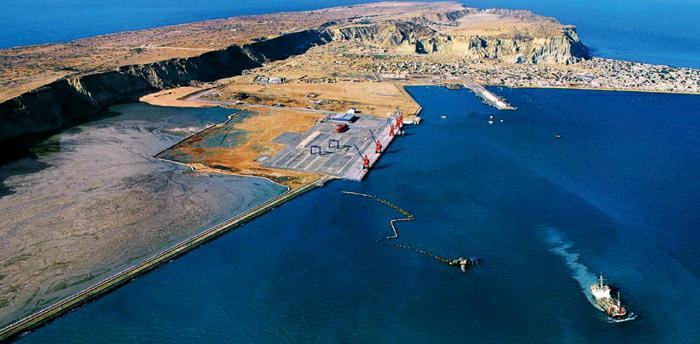Gwadar: Fishing a New Future
2017-05-20byHuZhoumeng
by+Hu+Zhoumeng
For years, Gwadar locals living in the southwestern tip of Balochistan, Pakistan, made a living fishing on the Arabian Sea, which is now one of the worlds busiest shipping routes. Waves from massive cargo ships pushed their small wooden boats back to the beaches, where thatched huts along the coast blended into the barren desert background.
Gwadar is home to a natural deep and warm-water harbor near main shipping lanes, with an anchor-shaped peninsula dispersing the waves. Seizing the citys potential to become a modern metropolis with a major seaport has been a Pakistani dream since the 1960s, but every plan stalled until a construction team from the China Communications Construction Company Ltd.(CCCC) arrived in 2002.
Starting from Scratch
Stricken by poverty and unrest, the 20,000 residents of Gwadar were mostly subsisting on meager incomes from fishing and constructing hand-made boats. Their electricity, delivered from miles away, was rarely stable, and their only source of fresh water, the Akara Kaur dam, frequently failed to meet demand. Lack of an industrial base and supporting infrastructure presented major challenges to the CCCC, despite its status as a veteran infrastructure constructor at over 200 ports in 95 countries.
“I couldnt even find a nail there,”remarks Sun Ziyu, vice president of the CCCC. “We simply started from scratch.” In the very beginning, cargo carriers arriving with construction materials had to anchor far from the undeveloped harbor and be un- loaded with local fishing boats. Sun likened it to ‘ants moving their house.
Despite the less-than-ideal conditions, the port took shape within three years due to unremitting efforts by both Chinese and Pakistani construction workers, whose daily diet was mostly potatoes and onions. Construction cranes popped up one after another, forklifts passed fresh warehouses in a well-paved stockyard and work boats docked near the shore.
When the first phase of the Gwadar port project was completed in 2005, the coastline of its main dock and three multifunctional berths extended more than 600 meters. Along with sea water desalinators and power generators, the port was also equipped with supporting facilities for water supply and drainage, firefighting and pollution prevention.
Inspired Trade Hub
Every five-rupee Pakistani banknote now features a portrait of Mohammad Ali Jinnah, founder of the country, on one side, and a horizontal view of the Gwadar port on the other. Pakistani Prime Minister Nawaz Sharif envisions an international port city that drives foreign trade and enables the country to better engage with the global economy.
In 2005, Singapores PSA International began managing Gwadar Port, but operations failed to live up to local authoritiesexpectations. The China Overseas Ports Holding Company (COPHC) took over management in 2013. After four years, the port has been revived with refurbished office buildings, stockyards of around 35 acres and heavily-used port facilities. Gwadar can now accommodate two 50,000-ton container ships simultaneously.
The Pakistani government is also cooperating with COPHC to develop a 2,281-acre free trade zone in Gwadar. Peripheral areas are taking on new looks as industrial parks are under construction. Within the next three years, a power plant with 300 MW capacity and more seawater desalina- tors are scheduled to be completed.
Gwadars best hotel, the Pearl Continental, is more frequently filled with businessmen from around the world. Environmental protection is being highly prioritized during the development of the Gwadar free trade zone. Commerce and trade companies are preferred, while industrial manufacturers must comply with strict limitations. Domestic companies, such as Jolta Tech, an electric bike producer, and Midtrans, a cooking oil maker, have decided to open shops there. The largest commercial banks in the country, Habib Bank Limited and United Bank Limited, as well as the insurance giant EFU General Insurance Ltd., are also expected to move in.
The Gwadar port, constructed as part of the US$46-billion China-Pakistan Economic Corridor (CPEC), is expected to connect to landlocked Central Asian countries and western China through highways and rails. In late 2016, a team of over 60 freight trucks arrived after a 15-day trip of over 3,000 kilometers from Kashgar in Chinas Xinjiang Uygur Autonomous Region. The first ever trip along the land route between the two cities testified to a reduction in cost and time for transportation compared to sea routes. The goods were then shipped to the Middle East and Africa.
The Gwadar port is the third largest of its kind in Pakistan—it has become a crucial logistics conduit as the city is becoming a trade center. Local authorities also hope to develop tourist attractions, recreational spaces and high-end real estate. Some have looked to Chinas southern trade hub Shenzhen, only a fishing village just three decades ago, as a model, and others to Dubai.
Local Choice
“Most workers hired for the first phase of the Gwadar port construction were local,” notes Peng Dapeng, vice president of the CCCC International, a company with over 2,000 employees in Pakistan.
Local employees worked well with their Chinese colleagues, and they often played soccer together. Religious beliefs were highly respected. The CCCC offered a flexible work schedule during the month of Ramadan, when Muslims dont eat or drink during daytime. To help with the lack of educational facilities, the company also donated computers and printers to schools.
“We placed considerable value on corporate social responsibility,” says Peng. “We were devoted to helping the local people.”
Three quarters of Gwadars 85,000 residents are employed in the fishing industry. However, they lack the necessary refrigeration facilities to meet export standards.
To ensure a booming fishing business better benefits locals, refrigerated boats and operational training are being offered to local fishermen, says Hu Yaozong, a senior manager working on the development of the Gwadar free trade zone.
Illiteracy in Gwadar remains as high as 75 percent, which impedes local workers from getting better jobs requiring more skills. Hu adds that a professional training center is being set up to enable more local people to seize new job opportunities emerging along with Gwadars development. Many have already been hired by Chinese companies to contribute to projects revitalizing their hometown.
